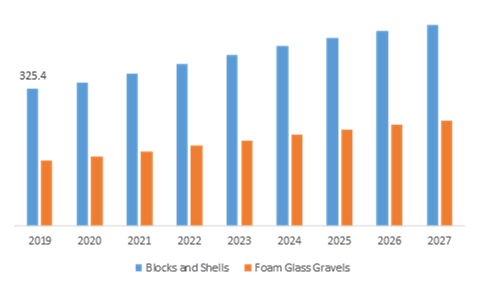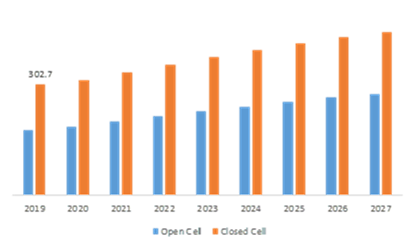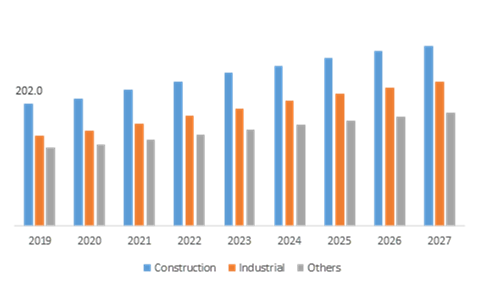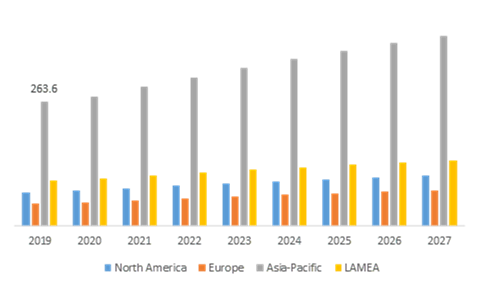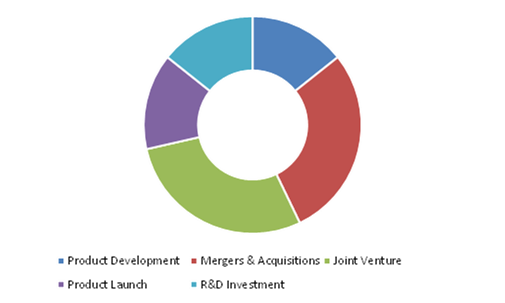Cellular Glass Market Report
RA00404
Cellular Glass Market, by Product Type (Blocks & Shells and Foam Glass Gravels), by Type (Open Cell and Closed Cell), by Application (Construction, Industrial, and Others): Global Opportunity Analysis and Industry Forecast, 2019–2027
The global cellular glass market is expected to generate a revenue of $724.8 million by 2027, increasing from $481.2 million in 2019 at a healthy CAGR of 5.4%. Asia Pacific region cellular glass market is expected to grow at a healthy CAGR of 5.6% by generating a revenue of $404.3 million by 2027.
Cellular Glass Market Analysis:
Cellular glass is manufactured through reaction between carbon and glass at elevated temperature. It is cellular structure glass material that offers enhanced insulation, lightweight and durable insulation to materials. Owing to its thermal properties, it is used widely as a thermal insulation material in chemical industries. It offers high compressive strength making it a suitable material for insulating roof tops covered with bitumen and other heavy materials. In addition, owing to its compatibility it is utilized with adhesives and in membranes that require barrier to air and liquid. These factors are expected to drive the global cellular glass market in the forecast period.
The cellular glass market is predicted to grow enormously in terms of revenue in the forecast period. The market is predicted to grow with the rise in the demand of cellular glass in various construction activities. The sudden outbreak of the COVID-19 impact have resultant in shutdown of various industrial and construction activities. With a span of time, when the unlock procedure starts, the demand for construction activities will increase. The cellular glass are lightweight, high strength and thermal with acoustic insulating properties due to which the cellular glass are mostly used in the construction activities which will eventually increase the demand for cellular glass, thus driving the global market in the estimated period.
Rising demand of cellular glass in building & construction application is anticipated to drive the global cellular glass market
Insulation materials are used in construction for providing thermal insulation. Rising population has enhanced the construction activity around the world. Construction end-users include residential, commercial, and civil construction. People are concentrating more on the energy saving process and cellular glass being suitable for this purpose, it is used as an insulation material in construction of floors, walls, and roofs. Moreover, rise in the construction of new homes, commercial buildings, and other construction activities will enhance the use of cellular glass in the forecast period. In addition, there are several other applications of cellular glass such as insulation material in cold storage facilities, flotation blocks for nets in submarines, and others that will increase the demand of cellular glass in the forecast period.
To know more about Cellular Glass Market Drivers, get in touch with our analysts here.
Properties such as fragility and high cost are major factors that are restraining the market growth in the predicted period
Despite its beneficial properties, there are several properties of cellular glass such as fragility, susceptible to induced damage due to vibrations, and high cost of cellular glass that are anticipated to decline the growth of the market in the projected period. Owing to its fragility, cellular glass can be broken due to vibrations on process lines, equipment, and utilities. Moreover, it is susceptible to various chemicals such as potassium and sodium hydroxide solutions. Thus, cellular glass cannot be used as an insulating material on the process lines, equipment, or utilities that handle these solutions. Availability of alternative insulating materials that offer the same physical and chemical properties at reduced cost is hampering the demand of cellular glass.
Rising construction activity around the world is foreseen to provide investment opportunity in the global cellular glass market
Growing population has led to an increased construction activity around the world. Cellular glass is being used as a thermal insulation material in construction activity which has already increased the demand of the global cellular glass market. Other applications of cellular glass in building facades, roof insulation, pools, and process pipe plant insulation is foreseen to offer investment opportunity in the global market. Cellular glass has multiple properties such as strength, moisture resistance, and stability, which has made it an appropriate insulation material in cryogenic applications such as low temperature pipe, chemical processing systems, heat transfer fluid systems, and others. Thus rising use of cellular glass in construction activity and process industries is foreseen to offer tremendous opportunities in the global market.
To know more about Cellular Glass Market Opportunities, get in touch with our analysts here.
Cellular Glass Market, by Product Type:
Blocks and shells sub-segment is predicted to be the most lucrative sub-segment
Source: Research Dive Analysis
Blocks and shells sub-sub-segment have the highest market share in the estimated period. Block and shells accounted for $325.4 million in 2019 and is predicted to grow with a CAGR of 5.0%. Flexibity of these blocks and shells is predicted to be the one of the major driving factors for the sub-segment in the estimated period. The blocks and shell cellular glass is used in most of the areas for having multiple benefits such as landscapping, foundation and backfills.
Cellular Glass Market, by Type:
Closed cell sub-segment will have a significant market share in the global market
Source: Research Dive Analysis
Closed cell sub-segment is predicted to have the highest market share. Closed cell sub-segment accounted for $302.7 million in 2019 and is predicted to grow with a CAGR of 5.1% in the estimated period. In closed cell type, the cells are pressured together so that the air and moisture don’t get inside the foam due to which it becomes more rigid and stable.
Cellular Glass Market, by Application:
Construction sub-segment is predicted to have maximum market share
Source: Research Dive Analysis
Construction sub-segment accounted for $202.0 million in 2019 and is predicted to grow with a CAGR of 5.2% in the estimated period. The glass foam provides high quality insulation for industrial purposes and protects against fire and is durable, which is predicted to drive the construction sub-segment in the estimated period. Moreover, increasing use of cellular foam in the construction of building and other structures is predicted to boost the sub-segment market in the forecast period.
Cellular Glass Market, by Region:
Asia-Pacific region has a lucrative market growth and it will reach up to $404.3 million by the end of 2027
Source: Research Dive Analysis
Asia-Pacific region market is predicted to have the highest market share in the estimated period. Asia-Pacific region market accounted for $263.6 million in 2019 and is predicted to grow with a CAGR of 5.6% in the estimated period. Rise in the use of cellular foam in construction activities, being frost free nature and having excellent load bearing capacity, is predicted to drive the region market in the estimated period. Europe region market accounted for $48.6 million in 2019 and is predicted to grow with a CAGR of 5.8% in the estimated period. Increasing use of cellular glass for thermal insulation for enhanced exteriors and presence of safety standards and norms for the production of cellular glass to enhance the load bearing capacity of the material is predicted to drive the region market in the estimated period.
Key Competitors in Global Cellular Glass Market:
Source: Research Dive Analysis
The major key players in the global cellular glass market players are CNUD-EFCO Operations S.A., Owens Corning, Amity Insulation Group Inc., SZECO Insulation Technology Co. Ltd., Zhejiang Zhenshen Insulation Technology Corp., Ltd., Zhejiang Dehe Insulation Technology Co., Ltd., Benarx, Jahan Ayegh Pars Co., Pinosklo, Polydros Sociedad Anonima (S.A), and others. Among these, in June 2019, Benarx and Beerenberg merged their business to enhance group’s company structure. In addition, the company will deliver their own products and will not interchange their product portfolio
Porter’s Five Forces Analysis for Cellular Glass Market:
- Bargaining Power of Suppliers: The switching barrier from one supplier to the other supplier is predicted to be high.
The bargaining power of suppliers is HIGH.
- Bargaining Power of Buyer: Due to the multiple benefits and multiple choice for the buyers is medium
The bargaining power of the buyer is MEDIUM.
- Threat of New Entrants: Government regulatory policies coupled with higher cost associated with R&D offer low threat of entry from new competitors.
The threat of new entrants is LOW.
- Threat of Substitutes: The threat of the alternative product is low as there are very less number of competitors in the market.
The threat of substitutes is LOW.
- Competitive Rivalry in the Market: Market players are mainly following technological advancements, alternative business strategies such as strategic partnerships; this is also a key factor for high competitive rivalry in the cellular glass market.
The competitive rivalry in the industry is HIGH.
| Aspect | Particulars |
| Historical Market Estimations | 2019-2020 |
| Base Year for Market Estimation | 2019 |
| Forecast timeline for Market Projection | 2020-2027 |
| Geographical Scope | North America, Europe, Asia-Pacific, LAMEA |
| Sub-segmentation by Product Type |
|
| Sub-segmentation by Type |
|
| Sub-segmentation by Application |
|
| Key Countries Covered | U.S., Canada, Mexico, Germany, France, UK, Italy, Spain, Russia, Rest of Europe, China, Japan, India, Australia, South Korea, Rest of Asia-Pacific, Brazil, Latin America, Middle East, Africa. |
| Key Companies Profiled |
|
Q1. What is the size of the cellular glass market?
A. The global cellular glass market size was $481.2 million in 2019 and is projected to reach $724.8 million by 2027.
Q2. Which are the major companies in the cellular glass market?
A. Owens Corning and Jahan Ayegh Pars Co are some of the key players in the global cellular glass market.
Q3. Which region possesses greater investment opportunities in the coming future?
A. The Asia-Pacific region possesses great investment opportunities for the investors to witness the most promising growth in the future.
Q4. What is the growth rate of the Asia-Pacific market?
A. The Asia-Pacific market for cellular glass market is anticipated to grow at 5.6% CAGR during the forecast period.
Q5. What are the strategies opted by the leading players in this market?
A. Business expansion, agreement, and merger are the key strategies opted by the operating companies in this market.
1. Research Methodology
1.1. Desk Research
1.2. Real time insights and validation
1.3. Forecast model
1.4. Assumptions and forecast parameters
1.4.1. Assumptions
1.4.2. Forecast parameters
1.5. Data sources
1.5.1. Primary
1.5.2. Secondary
2. Executive Summary
2.1. 360° summary
2.2. Type trends
2.3. Type trends
2.4. Application trends
3. Market Overview
3.1. Market segmentation & definitions
3.2. Key takeaways
3.2.1. Top investment pockets
3.2.2. Top winning strategies
3.3. Porter’s five forces analysis
3.3.1. Bargaining power of consumers
3.3.2. Bargaining power of suppliers
3.3.3. Threat of new entrants
3.3.4. Threat of substitutes
3.3.5. Competitive rivalry in the market
3.4. Market dynamics
3.4.1. Drivers
3.4.2. Restraints
3.4.3. Opportunities
3.5. Technology landscape
3.6. Regulatory landscape
3.7. Patent landscape
3.8. Pricing overview
3.8.1. By Type
3.8.2. By Type
3.8.3. By Application
3.9. Market value chain analysis
3.9.1. Stress point analysis
3.9.2. Raw material analysis
3.9.3. Manufacturing process
3.9.4. Distribution channel analysis
3.9.5. Operating vendors
3.9.5.1. Raw material suppliers
3.9.5.2. Product manufacturers
3.9.5.3. Product distributors
3.10. Strategic overview
4. Cellular Glass Market, by Product type
4.1. Blocks & Shells
4.1.1. Market size and forecast, by region, 2019-2027
4.1.2. Comparative market share analysis, 2019 & 2027
4.2. Foam Glass Gravel
4.2.1. Market size and forecast, by region, 2019-2027
4.2.2. Comparative market share analysis, 2019 & 2027
5. Cellular Glass Market, by Type
5.1. Open Glass
5.1.1. Market size and forecast, by region, 2019-2027
5.1.2. Comparative market share analysis, 2019 & 2027
5.2. Closed Glass
5.2.1. Market size and forecast, by region, 2019-2027
5.2.2. Comparative market share analysis, 2019 & 2027
6. Cellular Glass Market, by Application
6.1. Construction
6.1.1. Market size and forecast, by region, 2019-2027
6.1.2. Comparative market share analysis, 2019 & 2027
6.2. Industrial
6.2.1. Market size and forecast, by region, 2019-2027
6.2.2. Comparative market share analysis, 2019 & 2027
6.3. Others
6.3.1. Market size and forecast, by region, 2019-2027
6.3.2. Comparative market share analysis, 2019 & 2027
7. Cellular Glass Market, by Region
7.1. North America
7.1.1. Market size and forecast, by Product type, 2019-2027
7.1.2. Market size and forecast, by type, 2019-2027
7.1.3. Market size and forecast, by application, 2019-2027
7.1.4. Market size and forecast, by country, 2019-2027
7.1.5. Comparative market share analysis, 2019 & 2027
7.1.6. U.S.
7.1.6.1. Market size and forecast, by Product type, 2019-2027
7.1.6.2. Market size and forecast, by type, 2019-2027
7.1.6.3. Market size and forecast, by application, 2019-2027
7.1.6.4. Market size and forecast, by country, 2019-2027
7.1.6.5. Comparative market share analysis, 2019 & 2027
7.1.7. Canada
7.1.7.1. Market size and forecast, by Product type, 2019-2027
7.1.7.2. Market size and forecast, by type, 2019-2027
7.1.7.3. Market size and forecast, by application, 2019-2027
7.1.7.4. Market size and forecast, by country, 2019-2027
7.1.7.5. Comparative market share analysis, 2019 & 2027
7.1.8. Mexico
7.1.8.1. Market size and forecast, by Product type, 2019-2027
7.1.8.2. Market size and forecast, by type, 2019-2027
7.1.8.3. Market size and forecast, by application, 2019-2027
7.1.8.4. Market size and forecast, by country, 2019-2027
7.1.8.5. Comparative market share analysis, 2019 & 2027
7.2. Europe
7.2.1.1. Market size and forecast, by Product type, 2019-2027
7.2.1.2. Market size and forecast, by type, 2019-2027
7.2.1.3. Market size and forecast, by application, 2019-2027
7.2.1.4. Market size and forecast, by country, 2019-2027
7.2.1.5. Comparative market share analysis, 2019 & 2027
7.2.2. Germany
7.2.2.1. Market size and forecast, by Product type, 2019-2027
7.2.2.2. Market size and forecast, by type, 2019-2027
7.2.2.3. Market size and forecast, by application, 2019-2027
7.2.2.4. Market size and forecast, by country, 2019-2027
7.2.2.5. Comparative market share analysis, 2019 & 2027
7.2.3. UK
7.2.3.1. Market size and forecast, by Product type, 2019-2027
7.2.3.2. Market size and forecast, by type, 2019-2027
7.2.3.3. Market size and forecast, by application, 2019-2027
7.2.3.4. Market size and forecast, by country, 2019-2027
7.2.3.5. Comparative market share analysis, 2019 & 2027
7.2.4. France
7.2.4.1. Market size and forecast, by Product type, 2019-2027
7.2.4.2. Market size and forecast, by type, 2019-2027
7.2.4.3. Market size and forecast, by application, 2019-2027
7.2.4.4. Market size and forecast, by country, 2019-2027
7.2.4.5. Comparative market share analysis, 2019 & 2027
7.2.5. Spain
7.2.5.1. Market size and forecast, by Product type, 2019-2027
7.2.5.2. Market size and forecast, by type, 2019-2027
7.2.5.3. Market size and forecast, by application, 2019-2027
7.2.5.4. Market size and forecast, by country, 2019-2027
7.2.5.5. Comparative market share analysis, 2019 & 2027
7.2.6. Italy
7.2.6.1. Market size and forecast, by Product type, 2019-2027
7.2.6.2. Market size and forecast, by type, 2019-2027
7.2.6.3. Market size and forecast, by application, 2019-2027
7.2.6.4. Market size and forecast, by country, 2019-2027
7.2.6.5. Comparative market share analysis, 2019 & 2027
7.2.7. Rest of Europe
7.2.7.1. Market size and forecast, by Product type, 2019-2027
7.2.7.2. Market size and forecast, by type, 2019-2027
7.2.7.3. Market size and forecast, by application, 2019-2027
7.2.7.4. Market size and forecast, by country, 2019-2027
7.2.7.5. Comparative market share analysis, 2019 & 2027
7.3. Asia Pacific
7.3.1.1. Market size and forecast, by Product type, 2019-2027
7.3.1.2. Market size and forecast, by type, 2019-2027
7.3.1.3. Market size and forecast, by application, 2019-2027
7.3.1.4. Market size and forecast, by country, 2019-2027
7.3.1.5. Comparative market share analysis, 2019 & 2027
7.3.2. China
7.3.2.1. Market size and forecast, by Product type, 2019-2027
7.3.2.2. Market size and forecast, by type, 2019-2027
7.3.2.3. Market size and forecast, by application, 2019-2027
7.3.2.4. Market size and forecast, by country, 2019-2027
7.3.2.5. Comparative market share analysis, 2019 & 2027
7.3.3. India
7.3.3.1. Market size and forecast, by Product type, 2019-2027
7.3.3.2. Market size and forecast, by type, 2019-2027
7.3.3.3. Market size and forecast, by application, 2019-2027
7.3.3.4. Market size and forecast, by country, 2019-2027
7.3.3.5. Comparative market share analysis, 2019 & 2027
7.3.4. Australia
7.3.4.1. Market size and forecast, by Product type, 2019-2027
7.3.4.2. Market size and forecast, by type, 2019-2027
7.3.4.3. Market size and forecast, by application, 2019-2027
7.3.4.4. Market size and forecast, by country, 2019-2027
7.3.4.5. Comparative market share analysis, 2019 & 2027
7.3.5. Rest of Asia Pacific
7.3.5.1. Market size and forecast, by Product type, 2019-2027
7.3.5.2. Market size and forecast, by type, 2019-2027
7.3.5.3. Market size and forecast, by application, 2019-2027
7.3.5.4. Market size and forecast, by country, 2019-2027
7.3.5.5. Comparative market share analysis, 2019 & 2027
7.4. LAMEA
7.4.1. Market size and forecast, by grades, 2019-2027
7.4.1.1. Market size and forecast, by Product type, 2019-2027
7.4.1.2. Market size and forecast, by type, 2019-2027
7.4.1.3. Market size and forecast, by application, 2019-202
7.4.1.4. Market size and forecast, by country, 2019-2027
7.4.1.5. Comparative market share analysis, 2019 & 2027
7.4.2. Latin America
7.4.2.1. Market size and forecast, by Product type, 2019-2027
7.4.2.2. Market size and forecast, by type, 2019-2027
7.4.2.3. Market size and forecast, by application, 2019-2027
7.4.2.4. Market size and forecast, by country, 2019-2027
7.4.2.5. Comparative market share analysis, 2019 & 2027
7.4.3. Middle East
7.4.3.1. Market size and forecast, by Product type, 2019-2027
7.4.3.2. Market size and forecast, by type, 2019-2027
7.4.3.3. Market size and forecast, by application, 2019-2027
7.4.3.4. Market size and forecast, by country, 2019-2027
7.4.3.5. Comparative market share analysis, 2019 & 2027
7.4.4. Africa
7.4.4.1. Market size and forecast, by Product type, 2019-2027
7.4.4.2. Market size and forecast, by type, 2019-2027
7.4.4.3. Market size and forecast, by application, 2019-2027
7.4.4.4. Market size and forecast, by country, 2019-2027
7.4.4.5. Comparative market share analysis, 2019 & 2027
8. Company Profiles
8.1. CNUD-EFCO Operations S.A
8.1.1. Business overview
8.1.2. Financial performance
8.1.3. Product portfolio
8.1.4. Recent strategic moves & developments
8.1.5. SWOT analysis
8.2. Owens Corning
8.2.1. Business overview
8.2.2. Financial performance
8.2.3. Product portfolio
8.2.4. Recent strategic moves & developments
8.2.5. SWOT analysis
8.3. Amity Insulation Group Inc.,
8.3.1. Business overview
8.3.2. Financial performance
8.3.3. Product portfolio
8.3.4. Recent strategic moves & developments
8.3.5. SWOT analysis
8.4. SZECO Insulation Technology Co. Ltd
8.4.1. Business overview
8.4.2. Financial performance
8.4.3. Product portfolio
8.4.4. Recent strategic moves & developments
8.4.5. SWOT analysis
8.5. Zhejiang Zhenshen Insulation Technology Corp., Ltd.
8.5.1. Business overview
8.5.2. Financial performance
8.5.3. Product portfolio
8.5.4. Recent strategic moves & developments
8.5.5. SWOT analysis
8.6. Zhejiang Dehe Insulation Technology Co., Ltd
8.6.1. Business overview
8.6.2. Financial performance
8.6.3. Product portfolio
8.6.4. Recent strategic moves & developments
8.6.5. SWOT analysis
8.7. Jahan Ayegh Pars Co.
8.7.1. Business overview
8.7.2. Financial performance
8.7.3. Product portfolio
8.7.4. Recent strategic moves & developments
8.7.5. SWOT analysis
8.8. Pinosklo
8.8.1. Business overview
8.8.2. Financial performance
8.8.3. Product portfolio
8.8.4. Recent strategic moves & developments
8.8.5. SWOT analysis
8.9. Benarx.
8.9.1. Business overview
8.9.2. Financial performance
8.9.3. Product portfolio
8.9.4. Recent strategic moves & developments
8.9.5. SWOT analysis
8.10. Polydros Sociedad Anonima (S.A)
8.10.1. Business overview
8.10.2. Financial performance
8.10.3. Product portfolio
8.10.4. Recent strategic moves & developments
8.10.5. SWOT analysis
Cellular glass is a glass foam formed from a reaction between carbon and glass at elevated temperature. It is a glass material with cellular that offers enhanced insulation, lightweight and durable insulation to materials. Because of its thermal properties, it is widely used as a thermal insulation material in various chemical industries. Also, its high compressive strength makes it a suitable material for insulating roof tops covered with bitumen and other heavy materials. It is also utilized with adhesives and in membranes that require barrier to air and liquid.
Factors Enhancing Growth of the Industry
Insulation materials are those that are used in construction process for providing thermal insulation. Rising urban population has enhanced the construction activity around the world. Cellular glass is also used as an insulation material in construction of floors, walls, and roofs by the end-users. With the rise in urban population, the construction of new homes, commercial buildings, and other construction activities has enhanced the application of cellular glass in previous years. Cellular glass is also used as insulation material in cold storage facilities, as flotation blocks for nets in submarines. These are considered as the major attributors of the growth of the global cellular glass market.
Trending Developments of the Market
According to a report published by Research Dive, the leading players of the global cellular glass market players are CNUD-EFCO Operations S.A., Owens Corning, Amity Insulation Group Inc., SZECO Insulation Technology Co. Ltd., Zhejiang Zhenshen Insulation Technology Corp., Ltd., Zhejiang Dehe Insulation Technology Co., Ltd., Benarx, Jahan Ayegh Pars Co., Pinosklo, Polydros Sociedad Anonima (S.A), and others.
These market players are focusing on developing unique strategies including mergers and acquisitions, product launches, existing technology upgradation, and collaborations and partnerships to sustain the market competition.
Some of the recent advancements of the market are as follow:
- A recent news states that the Grenzebach Group agreed with the BMT Group to acquire its float glass engineering division CNUD EFCO GFT. With a worldwide presence, CNUD EFCO GFT is an annealing lehr and tin bath solutions provider. Besides the glass business, the company has worked on more than 300 float glass production lines.
- In June 2019, Benarx and Beerenberg merged their businesses to enhance group’s company structure. In addition, the company will deliver their own products and will not interchange their product portfolio.
- Headquartered in Belgium, Cnud-Efco has partnered with GFT to initiate a groundbreaking innovation in the glass industry. GFT is a young and ingenious tin-bath design company based out of German.
Impact of COVID-19 on the Cellular Glass Industry
Because of the unprecedented outbreak of coronavirus, the operations of industries and businesses has come to a drastic downfall. The pandemic is also impacting the cellular glass industry in a negative way. This is mainly because of the reduction in construction works.
However, there is also brighter side to this temporary halt of operations. Many leading companies of the industry have extended their support to the essential service providers during the pandemic by supplying them protective kits.
Conclusions
The leading players of the global market of cellular glass are focusing on R&D, other strategies such as partnership, merger and acquisition, and product launches to sustain the development of the market beyond the pandemic.
Personalize this research
- Triangulate with your own data
- Request your format and definition
- Get a deeper dive on a specific application, geography, customer or competitor
- + 1-888-961-4454 Toll - Free
- support@researchdive.com

